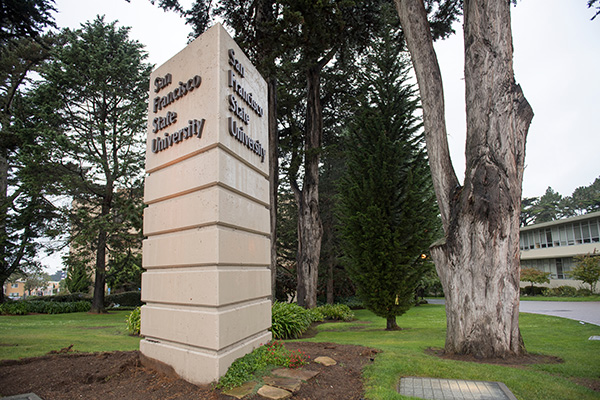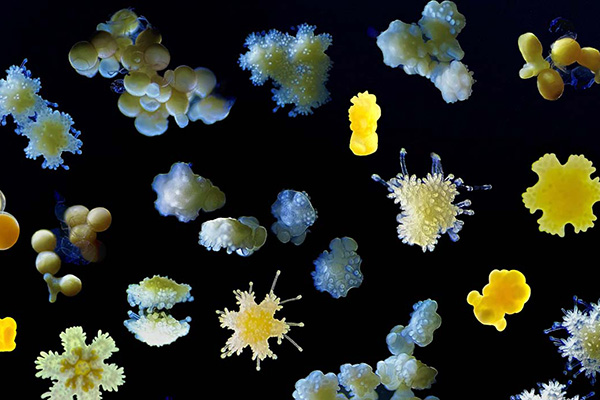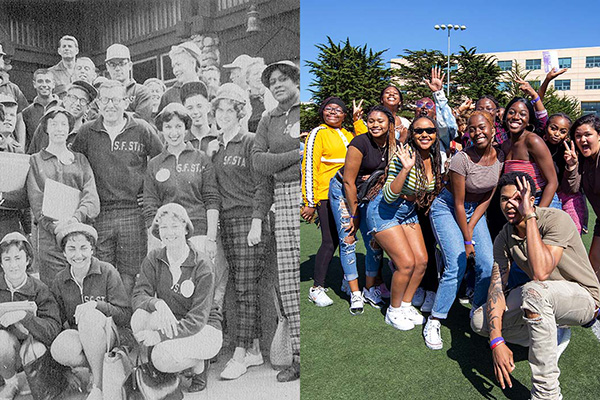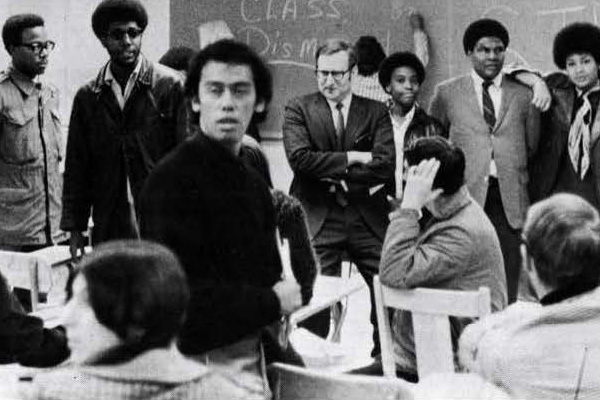News and Announcements

Not only did SF State earn a 4.5 out of 5 star rating in Money’s latest Best Colleges in America rankings, it also earned spots in three special categories: Best Public Colleges, Best Colleges in the West and Bests Colleges with High Acceptance Rates. Only 50 schools out of the 745 on the Best Colleges in America list earned a higher rating than SF State.
On the SF State profile page in the Money rankings, the University’s emphasis on community service learning is highlighted. “The school of nearly 21,000 undergrads and more than 3,000 graduate students was one of the first universities in the U.S. to offer academic credit for community work and include community service learning hours on students’ transcripts. Students can choose from hundreds of courses with a community service element in a wide variety of fields.”
Photo by Deanne Fitzmaurice

It’s not often that one gets to throw starfish a birthday party. Some species — like the six-rayed sea star Leptasterias — are notoriously difficult to keep alive in the lab, making even first birthdays a rarity. So when SF State researcher Berenice Baca achieved the seemingly impossible feat of raising Leptasterias specimens for an entire year, her lab made sure to celebrate.
Baca is among the first in her field to successfully rear Leptasterias embryos to reach the one-year milestone in the lab. And to think, this project started in an undergraduate class with SF State Biology Professor Sarah Cohen.
“Because of that study I started as an undergrad, I was able to grow [Leptasterias] up to a year, which is really exciting,” said Baca, who joined Cohen’s lab as an undergraduate researcher and is now an SF State master’s student. She’s been with this project for less than two years but she’s already shared her work at national and international conferences, won research awards, attended research workshops and worked with KQED to highlight these sea stars.
Baca’s work could help Leptasterias and other species feeling the impact of grave challenges. Sea stars face the constant threats of climate change and sea star wasting disease, a mysterious condition wiping out entire species. “We tend to notice or shift our attention towards certain species when it’s endangered or almost gone,” Baca explained. “We should try to address [these issues] now rather than wait until the species is almost completely gone.”
Baca studies the developmental patterns of two species of Leptasterias sea stars (Leptasterias pusilla and Leptasterias aequalis). These species reproduce via brood-fostering, which is akin to a hen sitting on her eggs. While somewhat common among other animals, it’s a rare approach among marine species. In the wild, maternal sea stars protect 50 – 1,500 embryos on their underside until their young stars are ready to be independent. Baca successfully raised these embryos to a juvenile stage in the lab without maternal care (i.e., without brooding). As part of this project, she developed protocols for this process and gleaned unique insight about Leptasterias development.
“As I was starting this project, I realized there’s no information on this, which drove me a little crazy,” Baca said, noting that the knowledge gap fueled her curiosity and determination.
Her first step was to give the sea stars a laboratory home as cold as their native habitat. Baca first raised the stars at 9 to 10 degrees Celsius in a classroom cold room before moving them to a dedicated deli fridge set at 12 to 13 degrees Celsius. Next, she needed to ensure that the stars didn’t starve. This was quite the saga, Baca explains, because the stars kept losing interest in readily available fish food. It turned out Baca’s microscopic juvenile starfish — approximately 0.2 cm in size — required live sea snails, copepods and barnacles they could hunt.
“I ended up getting these microscopic snails that required really fine tweezers to get them out of barnacles. I was doing this at 5 in the morning or very late at night because I have to correlate [my work] with the tides,” she explained.
Comparable studies on Leptasterias failed to grow the early juveniles in the lab and only one known study was able to hatch these stars. Extending Leptasterias’ lifespan in the lab gave Baca the opportunity to document their development as early as eight hours to 31 days, allowing her to capture beautiful images of fertilized eggs and snapshots of intermediate stages. By day 44, her juvenile stars began taking on a familiar six-armed star shape, and by 10 months the stars were 1.3 cm or bigger and started exhibiting hallmark coloration and patterns. Sharing her work at conferences, she was heartened to hear other scientists share excitement for her work and give her words of encouragement.
Baca and the Cohen lab even worked with KQED to feature Leptasterias in a new episode of its science video series “Deep Look.”
Growing up alongside her stars
Coming to SF State, Baca knew she wanted to do research, but she’s still a bit awestruck by how her research experience has evolved. When she enrolled in Cohen’s “BIOL 586GW: Marine Ecology Laboratory — GWAR,” Baca wanted research experience, but she didn’t anticipate it would lead her to pursue a master’s degree.
“It’s really nice that Sarah [Cohen] is really good at figuring out your interest and connecting you with the right people,” Baca said, explaining that Cohen encouraged her to apply for grants and scholarships, participate in conferences and attend science workshops. “That really helps. Sometimes you feel lost and having that [support] really helps in initiating your own project or research. It actually makes you feel like a scientist.”
With daily lab work, field research and conferences, being a scientist has become a big part of her life. Baca, a first-generation student, previously maintained multiple jobs and worked full-time in the fields picking blueberries and grapes to support her University education. Growing up in a small town that lacked proper science education, she had an unsatisfied desire to learn more. It’s that natural and unwavering curiosity that’s driven her throughout her research, especially when it gets hard.
“I’m really thankful for the entire Cohen lab,” Baca said, adding that Cohen’s and her lab mates’ support and encouragement have been instrumental. “I believe without them I wouldn’t have anything.”
Learn more about SF State’s Biology Department.
Photo by Berenice Baca

This year, SF State is reflecting on and celebrating its evolution over 125 years. SF State has undergone some dramatic changes over the years: There have been multiple names (beginning with “San Francisco State Normal School”), the main campus location has changed, and buildings have come and gone. Yet some beloved things — like students’ unwavering Gator spirit — remain unchanged.
In June, SF State’s Parking and Transportation office announced that it will not resume the SF State shuttle service between the Daly City BART station and campus this fall.
The shuttle has been free of charge for riders and fully funded by Parking and Transportation, which has experienced a drastic reduction in revenues as lower enrollments and hybrid learning and work schedules have resulted in lower revenues collected for parking permits and fees.
Free Muni 28 and 28R service to and from Daly City BART station will continue for students, faculty and staff (requires tagging your Clipper Card entering or exiting Daly City BART and tagging on Muni). The Gator Pass, which offers free Muni service to students, pre-tax transit and parking benefits for staff, and other area transit options will also continue.
Parking and Transportation will monitor usage levels and partner with Muni to ensure there is adequate bus service between the Daly City BART station and campus.
Please visit the Parking & Transportation website for the full announcement.
The Office of Student Affairs & Enrollment Management is thrilled to announce that after a national search, Anna Titus has joined the SF State community as the assistant vice president for Title IX and Discrimination, Harassment and Retaliation.
Titus is deeply committed to the work of sexual assault and harassment prevention, as well as anti-discrimination. She comes to SFSU from the University of South Carolina, where she served as the director of investigations and resolutions. She has also held roles in civil rights and investigations at The Ohio State University and the University of Oregon. In her previous work, she has developed university policies and procedures for resolving protected class-related complaints under the 2020 Title IX regulations. Additionally, she has hired and trained investigators and overseen investigations and mediations.
A native Oregonian, Titus received a Juris Doctor from the University of Oregon School of Law and a Bachelor of Arts degree in Political Science from the University of Oregon.
Titus is available to connect with campus partners; please call 415-338-2032. To report behaviors of concern, please use the Title IX & DHR reporting portal.
Strategic Marketing and Communications (SMC) is excited to introduce Google Looker Studio, a real-time, customizable dashboard reporting tool for web analytics. Looker Studio allows website editors and contributors to make informed, data-driven decisions to enhance their web strategies.
What is Google Looker Studio? Google Looker Studio is a powerful tool that transforms raw data from Google Analytics into easy-to-understand reports. These reports provide valuable insights that help website editors and contributors optimize their web content, track user engagement and improve overall website performance.
How does it help with website decisions? With this initial rollout phase, SMC will provide snapshot reports that distill the essential information from Google Analytics, eliminating unnecessary data and highlighting key metrics. As your web presence grows and campaigns are launched, Looker Studio can scale up its reporting capabilities to deliver deeper insights and more detailed analyses.
Benefits of Google Looker Studio:
- Real-time data updates
- Customizable reports tailored to your needs
- Simplified data presentation
- Scalable reporting as your web presence expands
Request Access: To request access to your Looker Studio report, please fill out the request form.
For more information about Google Looker Studio, please email SMC Digital Content Specialist Kevin Perez at kperez@sfsu.edu.
Summer is here and there’s no better time to give yourself some wellness love. Join the Kinesiology Department-sponsored program Fit Plus, and get your health and fitness in gear. Classes include yoga, strength training, Zumba and many more. Classes are held during lunch hours all through the week in person and some online.
The CSU Chancellor’s Office sponsors an online training on accessible document training series. “WebAIM Document Training” is a resource for anyone on campus responsible for document publishing. The course is open to the CSU community.
This training is provided in monthly cohorts, and completion awards a certificate. Accessibility concerns us all, and this program provides the most up-to-date information on creating accessible documents.
Academic Technology and the Center for Equity and Excellence in Teaching and Learning are excited to invite faculty to enroll in this summer’s Excellence in Online Pedagogies professional development offering.
The course is designed to equip faculty with essential approaches to designing and enhancing online synchronous and asynchronous courses.
Course topics:
- Evaluating online courses using quality standard rubrics
- Orienting students to online learning expectations
- Addressing the digital divide and inequities through course design
- Developing engaging, inclusive and collaborative online activities and assignments
- Humanizing online courses and creating social and cognitive presence
- Teaching strategies related to artificial intelligence
The Office of Human Resources invites all University employees to attend the CSU’s Got Talent webcast on Tuesday, July 16, 10 – 11 a.m. Viet Hoang, partner at Pint Sized Ideas, will present “Micro-Affirmations: Nurturing a Culture of Care through Small but Powerful Gestures.”
The longtime campus Technology Acquisition Request (TAR) process will relaunch this summer, introducing a new streamlined interface and process and a new name: BuyIT. After an extensive assessment of the process and its requirements, including user focus-group feedback sessions, the project team developed an application to support the new IT purchasing process. The new application provides a consistent and simplified experience intended to get even easier as application functionality is streamlined.
This change is part of a yearlong collaborative effort between Academic Technology, Information Technology Services and other campus partners, including Procurement and the Disability Programs and Resource Center. Focus groups and a staff and faculty user group have provided campus input that has been critical to this process improvement initiative.
Join an informational town hall meeting to learn more about the project, preview the new BuyIT application and ask questions about the future of information technology purchasing at SF State. Registration is required.
Town hall meetings:
- Wednesday, July 17, 11 a.m. – noon, Library 121. Please register via Microsoft Office Forms.
- Tuesday, July 23, 11 a.m. – noon (virtual). Please register via Zoom.
Please visit the BuyIT web page for more information.
Human Resources will host a presentation on the tuition reduction and fee waiver Program on Friday, July 26, 11 a.m. – noon, via Zoom. The program provides an opportunity for eligible employees, their spouse or their dependents to take classes at any CSU campus at a reduced rate. For employees, this can help with career development, undergraduate or graduate degrees.
The Office of Strategic Marketing and Communications will provide faculty and staff an opportunity to get a professional headshot photo taken for use on University web pages and in other communications. Photo shoots take place Tuesday, Aug. 13 – Thursday, Aug. 15, in Burk Hall 165. Appointments are on a first-come, first-served basis.
Staff are invited to the first Staff Forum of the 2024 – 2025 year on Wednesday, Aug. 14, 11 a.m. – noon, via Zoom. The agenda includes remarks from President Lynn Mahoney, a strategic plan update, employee supportive resources, new resources from the Office of Strategic Marketing and Communications and more. Human Resources is the host of the event. All campus staff, except Management Personnel Plan (MPP) or faculty, are encouraged to attend.
The 2024 – 2025 Opening Convocation will take place Thursday, Aug. 22, 8:30 – 11 a.m., in McKenna Theatre, Creative Arts building. It will also be streamed live online.
Connect with your colleagues, enjoy coffee and bagels and learn about academic resources. Distinguished faculty and staff awards will be announced, and new faculty will be introduced.
To share an academic resource or other opportunity with staff and faculty, please provide your contact information via Qualtrics.
Join Risk and Safety Services to learn more about Free Speech, Time, Place and Manner policies. The presentation will take place Wednesday, Sept. 11, noon – 1 p.m., in Mashouf Wellness Center, classroom 105.

Oba T’Shaka, professor emeritus and former chair of Africana Studies, wrote the following essay in memory of Nathan Hare, “the Father of Black Studies.”
The Passing of Dr. Nathan Hare, ‘A Great One’
On June 10, 2024, Dr. Nathan Hare joined the ancestors.
The founders of the greatest civilization in the history of humanity the civilization of Kemet, (known to the world as Egypt), were a people called the Anu. They defined themselves by three vertical registers that meant, “Great Ones!”
Who was Dr. Nathan Hare? He was a Great One! He was a fearless Black man who bravely fought the enemies of Black freedom, and Black truth with his fist, his mind, his writings, his teachings and through taking political action. Just as the Anu founded the greatest classical civilization in antiquity, so Dr. Nathan Hare as a representative of the best in African American culture, founded the discipline of Black Studies in the most alien of spaces the white college at San Francisco State College where Black students barely existed, and Black faculty and Black curriculum were nonexistent. Dr. Hare became the first coordinator of Black Studies in the United States and a participant in the successful strike for Black and Ethnic Studies that gave birth to the first Black Studies Department and College of Ethnic Studies in the United States.
As the leader of the only successful Black Freedom and Black Power Movement in the north in the sixties to today, The San Francisco Black Freedom and Black Power Movement and Chair of The Afro-American Institute, now PAPO (Pan African People’s Organization) it was my honor every day to walk the picket line of the SFSU Strike for Black Studies. There, Nathan and I became friends. After the strike, Nathan would come by PAPO’s headquarters, The Malcolm X Unity House, and we exchanged ideas on the state of the Black Liberation Movement and the work we were doing in the movement.
What impressed me most about Nathan was the originality of his mind. His thinking wasn’t restricted to any ideology. When he co-founded the Black Scholar Journal, he encouraged it to be a journal of thought that allowed a wide range of Black scholarship that caused Blacks to think. When the Journal became captured by a dogmatic leftist line, Nathan had to leave. He wasn’t going to be a slave to anyone’s thoughts.
In 1984, Nathan Hare authored a very important book entitled, “The Endangered Black Family.” Dr. Hare had a Ph.D. in Sociology from the University of Chicago, and he later acquired a second Ph.D. in Psychology. This book on the Black family was a seminal work. He was the first scholar to observe that between 1968 and 1984 the Black family had undergone more erosion than between 1619 and 1984. He noted that for over 100 years 75% of Black families had maintained a remarkable unity consisting of two-parent households. By 1984, this number had fallen to 50% two-parent households. Today, only 29% of Blacks live in two-parent households. A significant part of my writings and the writings of my other scholars on the Black family have addressed this issue first raised by Dr. Nathan Hare.
In 1984, I became chair of the Black Studies Department at San Francisco State University where I had been teaching since 1972. Dr. Hare was fired by Dr. Hayakawa at the end of the SFSU strike. Subsequently, he was white balled from teaching in the U.S. university system. The first person I hired was Dr. Nathan Hare, The Father of Black Studies. The students and faculty of Black Studies were happy to have the master home. I then got the Black Studies tenured faculty to agree to support Dr. Hare for the tenure-track position in Sociology. Dr. Lawford Goddard, a sociologist and lecturer in Black Studies, agreed to step aside as a candidate for this position in favor of Dr. Hare. My strategy for getting Dr. Hare approved for this position depended upon surprise, and had a good chance of Nathan being recommended by the Acting Provost Dr. Eric Solomon, who had been a supporter of the strike for Black Studies. As acting provost, he wasn’t concerned about pleasing the President of SFSU Robert Corrigan. Unfortunately, the university was tipped off about this recommendation, destroying the chance for success.
Nathan and I remained friends. He was supportive of my work. He volunteered to edit my first book, “The Political Legacy of Malcolm X.” When this book was reviewed by The New York Times, he was the first person who called me telling me that my book had been ranked first against all books on Malcolm X. In 2014 I received a call from Jamaica asking me to speak on Marcus Garvey’s birthday. Nathan recommended me to speak.
Nathan was my brother. I had his back and he had mine. For me, and for Black folks at large, he was a rare special human being who stood for the truth and didn’t compromise no matter the price. He has entered the heavenly station reserved for heroes. Enjoy the heavenly light of Freedom that you have earned my brother. On behalf of the faculty and students of Africana Studies, San Francisco State University. Hotep!
Photo: Nathan Hare (second from right) and student Sharon Jones (third from right), now an Africana Studies lecturer faculty, on the first day of the Third World Liberation Front Strike on Nov. 6, 1968.
SF State Spotlight
Marc Stein, the Jamie and Phyllis Pasker Professor of History, is interviewed on a PBS News Hour segment on June 30 about the “lavender scare” in the U.S. during the Cold War era. LGBTQ+ people were deemed unfit for federal employment and barred from civil service.
“For those who were in Washington, D.C., there was a developing, vibrant, community-based culture in bars, in parks, in parties. One could have a relatively full and interesting and dynamic private life,” Stein said. “But the workplace was a different story.”
Stein is also quoted in a June 6 story in the Los Angeles Times about Ernestine Eckstein, a pioneering Black lesbian activist in the 1960s.
A new perspectives article in the Journal of Experimental Biology highlights the value of letting the metaphorical gravitational pull of a model organism lead scientific inquiry. The opposite to this type of organism-centered approach is to think of a big scientific question first and choose the model organisms or systems to test the question. Both approaches have value, Biology Chair and Professor Vance Vredenburg and collaborators emphasize; however sometimes the organism-centered approach can be undervalued. The authors discuss how taking an organisms-centered approach is important for scientific discovery, conservation, the communication and perception of science, and more.
Social Work Lecturer Faculty Fredericka (Ricka) L. White (B.A., ’96; MSW, ’99) was recently named executive director/clinical director of Elpida Residential Programs Inc. She is the first licensed clinical social worker to lead this 31-year-old supportive independent living program for those managing chronic mental health challenges.
The Furniture Society highlighted the work of Professor Emeritus of Design Martin Linder on its website June 24 – 30. The web page features a bio of Linder and photos of over 20 of his designs, including tables, chairs, a chaise lounge, armoire, music stand and more.
Recreation, Parks, Tourism and Holistic Health Professor Erik Peper gave the invited lecture, “Tech Stress: Negative impact of technology on health and what to do about it,” for the International Stress Management Association in Kaap Doorn, The Netherlands, on June 18.
He gave an invited presentation, “Enhance health with biofeedback while using technology,” for the 51st annual meeting of the Japan Biofeedback Society on June 22.
On June 27, Peper gave the invited presentation “Tech Stress and How to manage it: An Interview by Honourable Justice Michael K. McKelvey with Professor Erik Peper.” It took place at the Judging Better, Judging Smarter (Joint Canadian Superior Courts Justice Association and National Justice Institute Program) in Calgary.
Associate Professor of Liberal Studies Nick Sousanis is a keynote speaker at the 2024 Graphic Medicine Conference, taking place Tuesday, July 16 – Thursday, July 18, at Technological University of the Shannon in Athline, Ireland. The conference focuses on the use of comics in health and health care.